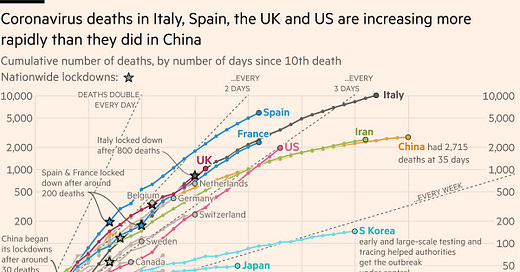In these days, you have probably seen charts like the one below. They are everywhere.


This chart has no purpose other than a hedonic one. For instance, we do know that deaths are undercounted (link to evidence) but we do not know by how much. This alone would be enough to trash the chart in the bin.
However, the journalist who made the chart will keep making it. This is because he is not interested in looking for the truth. He is interested in performing a ritual.
Scientism
Whereas science is the research of ignorance (whose byproduct is knowledge),
scientism is the ritualistic display of competence, regardless of whether it is rooted in reality.
A symptom of scientism is when research papers are judged on how well rituals of data manipulation are performed, with complete disregard of whether the assumptions are realistic or the input data is correct.
Another symptom of scientism is credentialism, the display of awards earned during ritualistic performances. Because those awards were achieved by memorizing a performance, they carry little predictive value on one’s ability to perform any feat other than repeating the memorized performance one more time.
Because credentials are awarded based on someone’s ability (to perform rituals), they give the impression of living in a meritocracy – even though there is little merit in performing something by mere imitation.
Recent examples of scientism
Spending 99% of our attention to pandemic-related news discussing data such as the number of cases and of deaths while spending less than 1% of our attention to wonder whether that data is reliable.
Listening to the WHO when it says that masks are useless even though evidence overwhelmingly says the contrary.
Failing to call bullshit on the WHO, because saying “the WHO says so” is an accepted ritual, whereas calling bullshit isn’t.
Countries using ritualistically-produced models to inform epidemic policy.
Downstream of scientism
Scientism does not only affect academia.
Leaders use scientism to legitimate their position, performing rituals mimicking some aspects of what they observe having worked in the past. Not because they think it might work, but because their followers think so.
Because leaders of nation use scientism to legitimate their position, it trickles down to society.
“Do the right thing” becomes “perform the right ritual”.
Soon, the role of schools becomes to teach rituals and the importance of rituals.
Societies affected by scientism degenerate in Ponzi schemes for the ability to judge how rituals are performed.
The very perception of living degenerates. Conversations become rituals in which people take turns to reassure the others that they are performing well.
Rituals have a purpose
It is not to say that all rituals are bad.
Some rituals have a benefit (which could be hidden), some are useless and others are harmful.
I’m still uncertain about how to reliably discriminate between the three.
However, scientism itself is bad, for it defeats the very purpose and functioning of science. It provides semblance of evidence, noise, which might cause the smartest of us to see patterns where there aren’t, jumping to the wrong conclusions, sometimes with terrible results.
Upstream of scientism
Scientism is rooted in the belief that to be smart one must look smart, that for something to work, it must make sense.
This belief is a confabulation for our tendency to fallback to appearance when we cannot judge substance.
Defeating scientism
There are two paths to defeat scientism. The first one is to make sure that everyone is competent enough to be able to independently judge the competence of others, or at least competent enough to spot bullshit.
This is hardly feasible due the operational complexities of deploying know-how at scale (also due to limited resources) and to the fact that it could lead to an arms race at looking competent vs spotting bullshit.
The second path to defeat scientism is to ensure that those in decision-making positions have skin in the game. As Nicholas Nassim Taleb explains in his homonymous book, skin in the game works not only as an incentive but mostly as a filter: who take decisions at risk of causing harm and have skin in the game are bound to self-destroy and to remove themselves from the pool. For example, we do not have many terrible car drivers because terrible car drivers die in car accidents.
PS: Today, I didn’t get the time to produce the daily headlines email. On Sundays mornings, I write another newsletter, which you can read on Luca-Dellanna.com/newsletter




Dear Luca, I hold a contradiction here. On one hand I completely agree with your post -truthfully I do. On the other hand, I find that the work done by many in keeping track of numbers, producing charts, etc, are extremely useful. For instance I rely on Max Roser and OurWorldInData. We need more data, not less. But we need to communicate uncertainty and even more so, risk -absolutely! Perhaps this is the point where we most agree: I also look at this event through the lens of Taleb, tail risks, decision making in conditions of uncertainty, Gigerenzer, etc. And in fact insofar as the stats are presented while accepting the great uncertainty, data is useful -and quite a lot. On that note I will send you an email as I find your investigations very fruitful. A presto